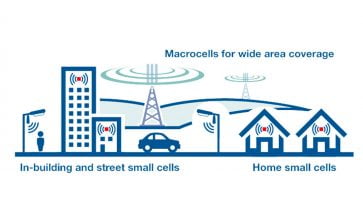How mobile networks are built
Mobile devices work by sending and receiving low power radio signals, much like a 2 way radio system. The signals are sent to and received from antennas that are attached to radio transmitters and receivers, commonly referred to as mobile phone base stations. The base stations are linked to the rest of the mobile and fixed phone network and pass the signal/call on into those networks.
A mobile phone base station provides coverage to a geographic area known as a “cell”. Cells are aligned next to each other in a similar pattern to a honeycomb, and it is for this reason that mobile networks are sometimes referred to as “cellular” networks.
The location of the base station within the cell is determined by a number of factors, including topography and other physical constraints such as trees and buildings, the cell ‘capacity’ or number of calls expected to be made in the cell, the amount of data usage, and the radio frequency at which the base station will operate.
A mobile phone needs to have ‘sight’ of a mobile phone base station. In other words, the radio signal from the phone to the base station needs to be uninterrupted. Hills, trees and tall buildings can obscure this line of sight and so base stations need to be very carefully located to maximise the coverage available.
Each base station carries a finite amount of traffic. In areas of high mobile and data use, such as central business districts and high density or population areas, more base stations are required to handle the level of traffic. In high use areas, there are often a range of base stations, from very specific in-building solutions (designed to give quality coverage within a specific building), to very small base stations known as ‘microcells’ and small cells.
Small cells provide mobile phone coverage or additional network capacity to a small geographic area, particularly in areas of high mobile device usage. They operate at a lower power than a traditional mobile phone base station and use smaller equipment. Small cell technology replaces technology previously known as microcells and operates in a similar way.
In areas where phone and data usage is not as high, base stations will often be located on hills or tall structures such as towers or poles to maximise the coverage area.


